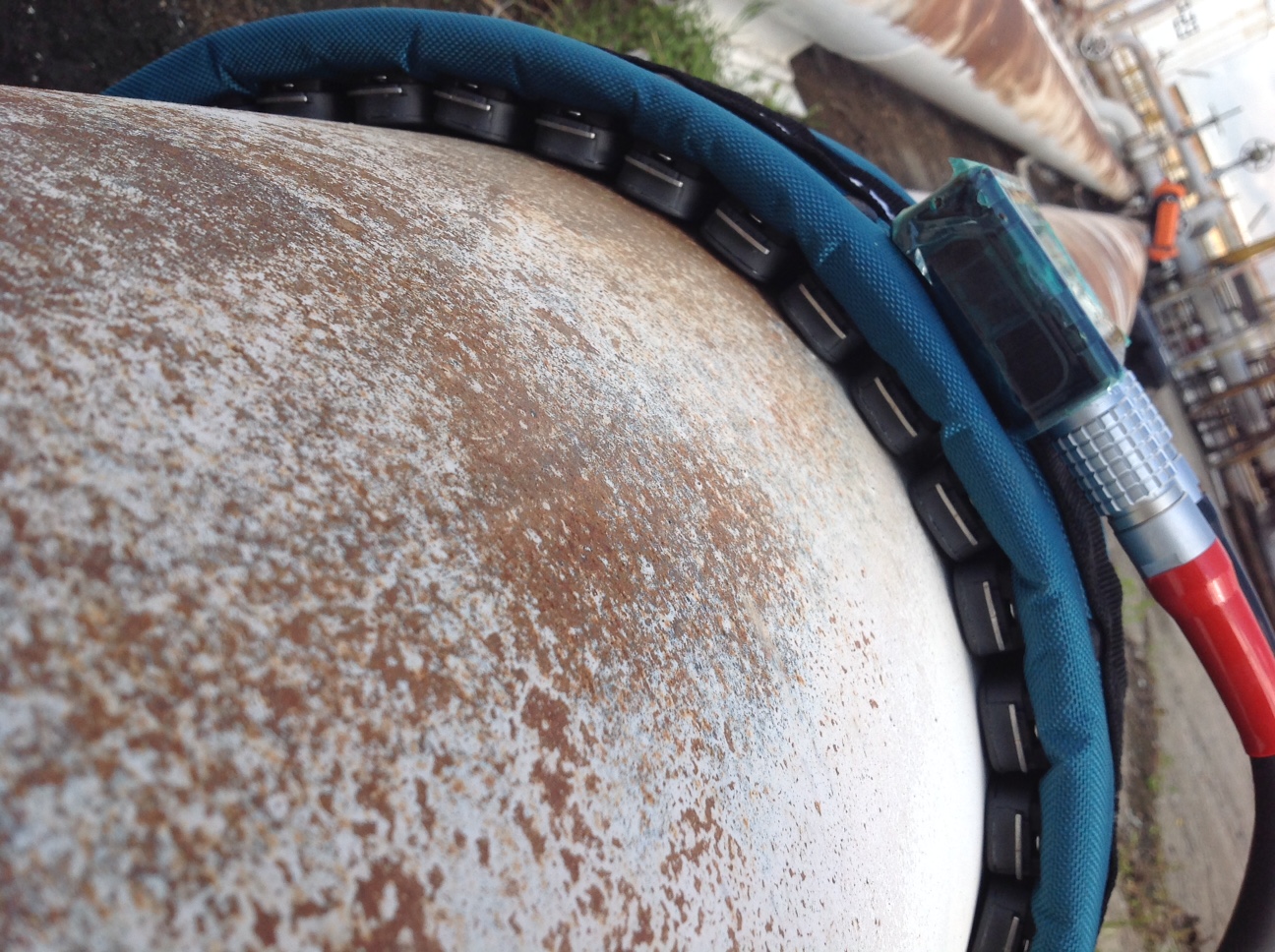Guided Wave Testing (GWT) is used by Swiss Approval network, under the supervision of UK Advanced NDT staff of authorised Inspectors. This method is proposed, as, a well-established method for pipeline inspection.
The GWT exploits mechanical stress waves that are guided along the wall of the pipe and can travel long distances, so it rapidly provides close to 100% coverage. A transducer injects a wave signal at a chosen location on the line and then receives echoes returning from any features or discontinuities. The arrival time of the echoes indicates the distance of these reflectors from the transducer. The typical test range performance is 50- 100m, but a range up to 500 m can be achieved, provided the pipe condition is excellent.
In some cases, there is no alternative inspection method, so the use of Guided Waves avoids expensive invasive investigations such as excavation.
Guided wave testing has become a well-established method for inspecting pipelines. It is important to know that it is a screening technique, that should be used to detect, locate, and classify discontinuities. Follow-up inspection with a quantitative nondestructive testing technique, should be performed to precisely measure discontinuity dimensions.
Guided Wave Testing, as a Screening Tool, It is vital to recognize that the conventional role of guided wave testing today is screening with exceptional advantages. Guided waves can provide full coverage of the pipe within the test range, identifying all locations where a subsequent, thorough, detailed inspection is required. In other words, GWT provides detection, and local follow-up inspection, provides just the correctly assessing the severity.
Choice of Mode
For many years, the equipment with GWT, used longitudinal waves. However, last generation of equipment is using torsional waves. Swiss Approval owned equipment, is using the torsional mode, which is much superior to the longitudinal mode, in the vast majority of applications. This is because of the following reasons:
- The torsional mode requires only two transducer rows
- The wave velocity does not change with frequency.
- It is in-sensitive to liquids inside or outside the pipe.
- There are two longitudinal modes propagating in the test range, which leads to false indications with this mode; the torsional mode does not have the problem of false indication.
Performing a Guided Wave Test
Guided wave equipment can display the results of the test as an A-scan, showing distance along the pipe, and as a C-scan, providing a view of the unrolled pipe.
Application Examples
Guided wave testing is applicable to a wide range of different scenarios, offering efficiency and coverage improvements, over alternative NDT methods.
Diameters of pipes to be inspected: From one (1) inch, two (2), three (3), four (4) inches, up to 50 inches.
Rapid Long-Range Screening
One of the main strengths of GWT is the rate of inspection coverage of pipelines that can be achieved. This is due to the ability to screen many meters of pipe from a single test point. During the inspection of 508 mm (20 in.) gas pipe, from a single installation of the transducer ring on the pipe, it was possible to inspect 230 m of pipe: 100 m in the negative direction and 130 m in the positive direction. The inspection results indicated that there was no corrosion present in the test range, but they did highlight misalignment in some girth welds.
Corrosion Under Insulation
The widespread problem of corrosion under insulation was one of the driving applications for the initial development of GWT. A short section of insulation (approximately 1 m) is required to be removed from the pipe in order to install the transducer ring. From this test position, many meters of pipe in either direction can be assessed for the presence of corrosion under insulation. This represents a significant improvement in productivity and integrity assurance over conventional techniques of inspecting for this type of corrosion (for example, radiographic techniques), which can miss degraded areas because they do not inspect the full cross section of the pipe.
High Temperature Pipe
Swiss Approval equipment has been specifically designed for the inspection of high temperature pipework, up to temperatures of 350 °C. In one example, a high temperature inflatable ring was used in the inspection of a 203 mm (8 in.) diesel pipe that was at a temperature of 240 °C. An area of corrosion was identified and followed up with conventional inspection techniques.
Calibration Blocks
Swiss Approval Laboratory Staff is working consistently to guaranty the maximum efficiency and reliability of our Testing Results.
Specific Calibration Blocks for each Pipe Diameter, for different materials, related to different International Standards, are designed and developed within our Laboratory, in order to build in house our Know-How, necessary for service delivery of excellence.
Development of inspection capacity for this category of materials, usually includes many, if not all, of the following:
- Modelling,
- Simulation,
- Fabrication of mock-ups and samples containing realistic defects,
- Procedure development,
- Validation and subsequent training.
Such development of inspection resources and capacity represents for Swiss Approval Top Management, substantial commitments of time, high qualified personnel and significant capital investment.
Accreditation ISO 17025
Swiss Approval Advanced Laboratory based in Europe, is currently under ISO 17025 accreditation process.

